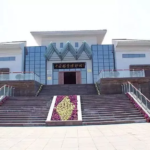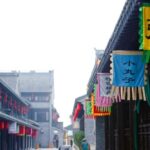Originally named Baoying Temple, Langya Temple was founded by Li Youqing, the governor of Chuzhou during the Dali period of the Tang Dynasty, and Monk Fachun. It is said that before building the temple, Li Youqing and Monk Fachun first drew a picture and presented it to Emperor Daizong of the Tang Dynasty. Coincidentally, Emperor Daizong dreamed the night before that there was a temple deep in a mountain forest. Its shape and scale were quite similar to those drawn on the picture. Emperor Daizong was very happy and specially bestowed the name ‘Baoying’. Later, it was renamed ‘Kaihua Chan Temple’ and ‘Kaihua Lv Temple’. Since it is located in Langya Mountain, people generally call it Langya Temple. Langya Temple is adjacent to mountains and forests, and its architecture is magnificent. The largest buildings in the temple are the Great Buddha’s Hall and the Sutra Depository. The Great Buddha’s Hall is 14 meters high and 15.3 meters deep. It is adorned with carved beams and painted pillars, which is very spectacular. Inside the hall are statues of Tathagata Buddha, Avalokitesvara, and eighteen arhats. The Sutra Depository is built at the highest point of the temple. Looking down from a height, it is said that there was once a Pali-leaf sutra hidden in the building. Other buildings in Langya Temple include the Beamless Hall, Mingyue Hall, Chanting Buddha Tower, Zhiyuan Garden, and Wujing Hall. Some are in the front and some are in the back. Some are high and some are low. They complement each other and form a majestic and beautiful picture of a mountain temple. Its natural scenic spots include Guiyun Cave, Xuehong Cave, and pine on the stone. Each has its unique and ingenious posture. Due to the changes of the world, Langya Temple and its surrounding buildings have been built and destroyed several times. Many pavilions and terraces have long disappeared. Most of the current buildings were rebuilt by Abbot Daxiu. The architecture maintains the original layout and style of ancient times. Many steles, stone carvings, and ancient bricks can still be seen. Therefore, there is a couplet inside the main entrance of Langya Temple that says: ‘The ancient temple still has stones from the Ming Dynasty, and the mountain gate still has bricks from Jiankang.’ In addition to some buildings from the Ming Dynasty, there are also Tang steles and Song engravings, all of which have high historical and cultural relic value.
Opening hours: Open all year round from 07:30 to 17:30.Langya Temple
Originally named Baoying Temple, Langya Temple was founded by Li Youqing, the governor of Chuzhou du[...]









